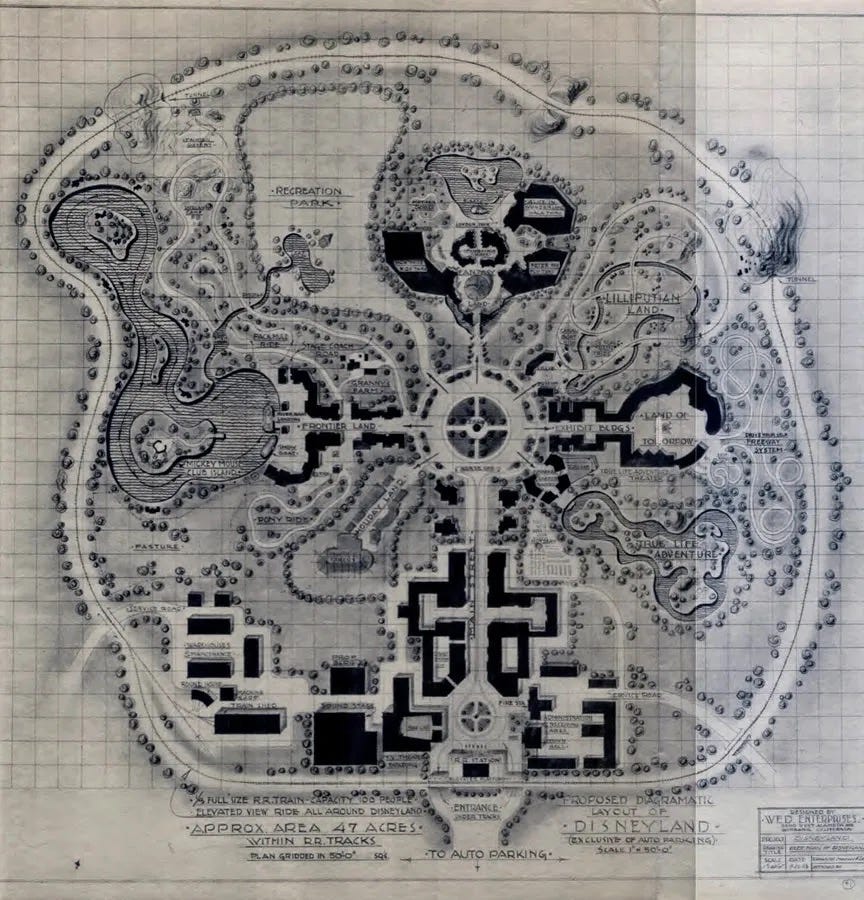The Blueprint for Magic: Walt Disney's Pitch That Built Disneyland
Monday Magic: Look back 70-plus years to see Walt Disney's original thoughts on Disneyland
As we prepare for Disneyland’s 70th anniversary, there is no better time than to go back to the park’s beginning. To do this we take a close look at The Disneyland Prospectus, the pitch material Disney used to secure funding.
Walt Disney had been fascinated with amusement parks for a long time after taking his children to zoos and carnivals. He wondered why there wasn’t a more immersive park experience that would appeal to both children and adults.
In 1948, he first put down his thoughts on what would be included in a park to one of his production designers Dick Kelsey. The memo laid out in some detail a park that contained:
A Railroad Station
Town Hall, with a real Post Office. “(Note: Check with Burbank on how to go about getting our own postal stamp),” the memo stated.
Fire Station
The Horse Car
A Doll Store
Hobby Shop
Magic Shop
A Carnival Section with “roller coasters, merry-go-rounds… typical Midway stuff.”
An Opera House
The Movie Theatre
The Western Village with a general store with a soda fountain and lunch counter. “We could sell most of the articles we have in the drug store in the village but we would also sell Western toys, Western outfits, toy guns, etc.”
Five years later, in 1953, these initial thoughts were expanded into what has become known as The Disneyland Prospectus. This set of documents was feverishly created in 42 hours over a weekend by Walt Disney and artist Herb Ryman so Walt and his brother Roy could pitch the idea to financiers.
Seeking crucial financing, Roy Disney journeyed to New York on Sept. 28, 1953. His initial attempts with broadcast giants CBS and NBC proved fruitless. However, his fortunes turned when he approached the up-and-coming ABC-Paramount company. What followed was a groundbreaking, seven-year television deal—the largest of its kind at the time. This agreement saw ABC invest $500,000 and provide a $4.5 million line of credit, in exchange for a 35% stake in Disneyland. Furthermore, Disney would supply ABC with a weekly one-hour TV show, additional productions, and access to their film library, for which ABC would pay for the production of the shows. Crucially, a provision allowed Disney to repurchase ABC's share of Disneyland after the seven-year period. In 1960, Disney bought out the ABC investment in Disneyland for $7.5 million.
The Disneyland Prospectus
The Disneyland Prospectus includes a drawing of what Disneyland might look like and nine pages of type explaining what would be included in this park. In many ways, the original pitch sounded like a combination of a theme park/television studio. (Something that would eventually happen at Disney’s Hollywood Studios when it opened at Walt Disney World in 1989 as Disney–MGM Studios Theme Park
A good portion of what was in Walt’s head that was placed in the proposal came to fruition. And like with many ideas, there has been tinkering along the way. Here is a summary of what areas would be included in the park:
Railroad Station: This was a must. Walt’s love of trains made this an absolute.
Main Street: Under the proposal, an Old Opera House would be the location for the filming of The Walt Disney Television Show.
The Hub: The central location to head to any of the lands. This remains the major design ingredient for theme parks around the world.
True-Life Adventureland: This was where you would embark on a boat for a trip down the River of Romance.
World of Tomorrow: A moving sidewalk would bring people to this location, which would be the home to the World of Tomorrow Television Show.
Lilliputian Land: Does this sound familiar? “A miniature Americana village inhabited by mechanical people nine inches high who sing and dance and talk to you as you peek through the windows of their tiny shops and homes. In LILLIPUTIAN LAND, there is an Erie Canal barge that takes you through the famous canals of the world, where you visit the scenic wonders of the world in miniature …” This turned into the Storybook Land Canal Boats, where you tour enchanting homes and villages from classic Disney movies in miniature. The main concept behind this is about the canals that would eventually become the famous “it’s a small world” attraction, which debuted 10 years later at the 1964 New York World’s Fair and then moved to Disneyland.
Fantasy Land: The plan was already in place with a ride-through of Snow White’s Adventures, a flying Peter Pan ride, and a walk-through Alice in Wonderland area.
Recreation Land: “A shady park set aside for reservations by clubs, schools, or other groups for picnics and special outings.”
Frontier Country: “Along FRONTIER STREET is a Harness Shop and a Blacksmith Shop, Livery Stable, Assayer’ s office, Sheriff’s Office, and the jail. You can get real Western food at the Chuck Wagon, and cowboy clothes, six-shooters, or a silver-mounted saddle for your horse or pony at the General Store.”
Mickey Mouse Club: Located on Treasure Island, this area would be the world headquarters for The Mickey Mouse Club and be where The Mickey Mouse Club Television Show would be produced.
Holiday Land: A place for special and seasonal attractions.
Even after 70 years, a dozen of the original rides and attractions that debuted on Disneyland's opening day, July 17, 1955, are still in operation, albeit updated and slightly altered. Of course, the park has transformed significantly since then, now encompassing two theme parks and undergoing another major expansion. This evolution has brought exciting additions, like the immersive Star Wars: Galaxy's Edge.
And it will continue to change. As Walt Disney said: "Disneyland will never be completed. It will continue to grow as long as there is imagination left in the world."





